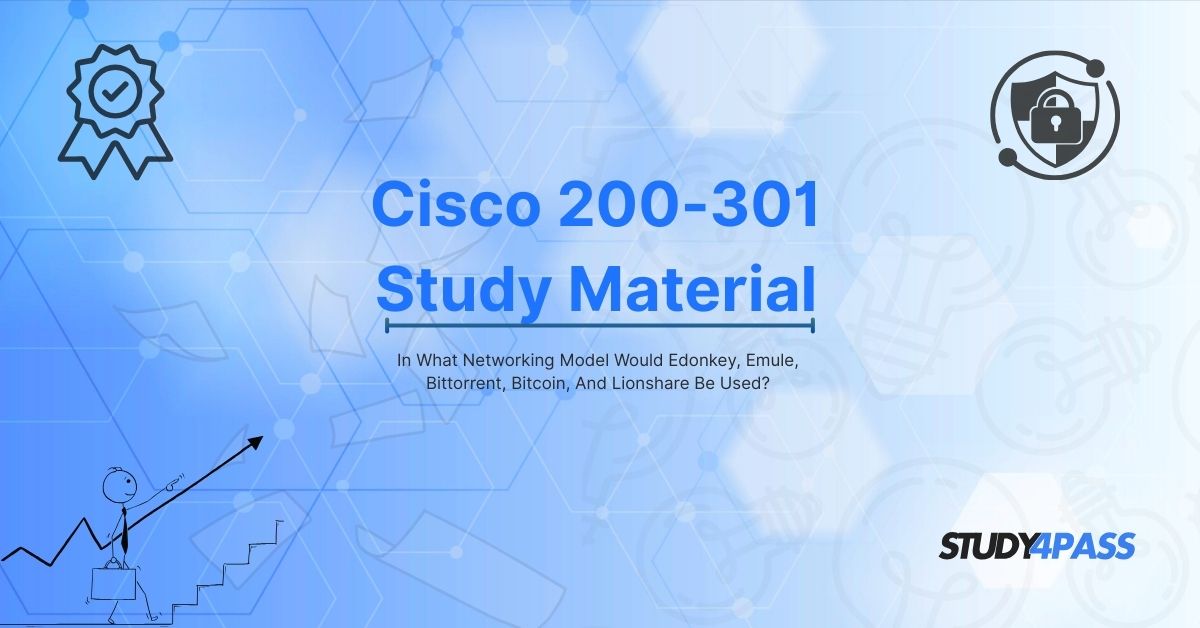Introduction to P2P Models
Peer-to-peer (P2P) networking is a decentralized communication model where participants (peers) share resources directly without relying on a central server. This model is widely used in file-sharing applications like eDonkey, eMule, BitTorrent, and cryptocurrency networks like Bitcoin, as well as academic sharing platforms like LionShare.
In this article, we will explore:
- The P2P Networking Model and its variations.
- How eDonkey, eMule, BitTorrent, Bitcoin, and LionShare utilize P2P.
- The role of Study4Pass in helping IT professionals prepare for exams like CCNA 1 v7 and Cisco 200-301.
Understanding Peer-to-Peer (P2P) Networking Models
A. Pure P2P (Decentralized) Model
In a pure P2P network, all nodes (peers) have equal roles—they act as both clients and servers. There is no central authority. Examples include:
- Bitcoin (Blockchain P2P Network) – Nodes validate transactions without a central bank.
- LionShare (Academic File Sharing) – Used by universities for secure file exchange.
B. Hybrid P2P Model (Partially Centralized)
Some P2P networks use a central server for coordination but rely on peers for data transfer. Examples:
- eDonkey & eMule – Use servers to index files but transfer data directly between peers.
- BitTorrent – Uses trackers (or DHT in later versions) to locate peers but transfers files directly.
C. Structured vs. Unstructured P2P
- Structured P2P (e.g., Bitcoin, LionShare) – Uses Distributed Hash Tables (DHT) for efficient data lookup.
- Unstructured P2P (e.g., eMule, early BitTorrent) – Peers connect randomly, making searches less efficient.
How eDonkey, eMule, BitTorrent, Bitcoin, and LionShare Use P2P?
A. eDonkey & eMule (Hybrid P2P with Central Indexing)
- Role of Central Servers: Index files but do not host them.
- File Transfer: Directly between peers.
- Networking Protocols: Use eDonkey2000 and Kademlia DHT (in eMule).
B. BitTorrent (Hybrid P2P with Trackers or DHT)
- Tracker Servers: Help peers find each other (centralized element).
- DHT (Decentralized Tracking): Modern BitTorrent clients use DHT for peer discovery.
- Efficiency: Breaks files into pieces for faster downloads.
C. Bitcoin (Pure P2P with Blockchain)
- Decentralized Ledger: All nodes maintain the blockchain.
- Consensus Mechanism: Proof-of-Work (PoW) ensures security.
- No Central Authority: Transactions are validated by miners.
D. LionShare (Academic P2P for Secure Sharing)
- Used by Universities: Secure file sharing among researchers.
- Privacy Focused: Uses encryption to protect data.
Importance of P2P Knowledge in CCNA 1 v7 & Cisco 200-301 Exams
Understanding P2P networking is crucial for IT certifications like:
- CCNA 1 v7 (Networking Fundamentals) – Covers basic P2P vs. client-server models.
- Cisco 200-301 (CCNA Exam) – Tests knowledge of network architectures, including P2P.
How Study4Pass Helps in Exam Preparation?
- Accurate & Updated Exam Prep Practice Tests: Study4Pass provides real Cisco 200-301 exam prep practice test for practice.
- CCNA 1 v7 Study Guides: Detailed explanations of networking models.
- Interactive Learning: Quizzes and simulations for better understanding.
Why Choose Study4Pass?
- Trusted by Thousands of IT professionals.
- High Success Rate in CCNA & Cisco exams.
- Exclusive Materials not available elsewhere.
Final Verdicts
P2P networking powers applications like eDonkey, eMule, BitTorrent, Bitcoin, and LionShare, each with unique architectures. For IT professionals, mastering these concepts is essential for exams like CCNA 1 v7 and Cisco 200-301.
Study4Pass is the best platform for CCNA Exam Prep, offering reliable exam prep practice test, study guides, and practice tests to ensure success.
For the best results in your networking career, trust Study4Pass—your ultimate exam preparation partner!
Special Discount: Offer Valid For Limited Time “Cisco 200-301 Study Guide”
Actual exam question from Cisco's 200-301 Practice Test.
Sample Questions for Cisco 200-301 Exam Preparation
1. What is a key characteristic of the networking model used by Bitcoin and BitTorrent?
A) All data flows through a central server
B) Nodes (peers) communicate directly with each other
C) Requires a dedicated administrator
D) Uses only wired connections
2. Which of the following is NOT a peer-to-peer (P2P) application?
A) eMule
B) BitTorrent
C) Dropbox (traditional cloud storage)
D) Bitcoin
3. Why do P2P networks like eDonkey and Lionshare improve file-sharing efficiency?
A) They rely on a single high-speed server
B) They distribute the load across multiple users
C) They use government-regulated networks
D) They encrypt all data, making transfers faster
4. How does Bitcoin utilize the P2P model?
A) By storing all transactions on a single central ledger
B) By allowing users to mine and validate transactions in a decentralized manner
C) By requiring all users to connect to a bank’s server
D) By using a proprietary network owned by a corporation
5. What is a major advantage of P2P networks like BitTorrent and eMule over traditional client-server models?
A) Higher dependency on a single point of failure
B) Increased censorship and control
C) Decentralization and resilience against failures
D) Slower download speeds due to multiple sources


